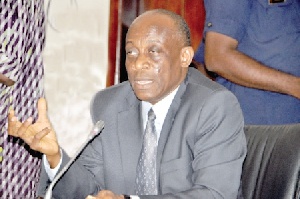- Home - News
- TWI News | TV
- Polls
- Year In Review
- News Archive
- Crime & Punishment
- Politics
- Regional
- Editorial
- Health
- Ghanaians Abroad
- Tabloid
- Africa
- Religion
- Election 2020
- Coronavirus
- News Videos | TV
- Photo Archives
- News Headlines
- Press Release
Business News of Tuesday, 15 September 2015
Source: B&FT
Govt’s debt reaches dreaded levels
Ghana’s public debt stock has now reached GH¢94.5billion as at June this year, further raising concerns of debt overhang if government does not curtail its appetite for borrowing.
The Bank of Ghana, which is expected to give an assessment of the economy today, has reported that the country’s debt level now represents 70.9 percent of Gross Domestic Product (GDP) -- which is classified by many economists as unsustainable or hitting levels that might make it difficult for government to settle these debts on time.
In May this year, when the Monetary Policy Committee of the central bank met, it put the country’s debt at GH¢89.5billion -- equivalent to 67.5 percent of GDP -- and the plans by government to borrow a further GH¢25.36billion in addition to the planned US$1.5billion Eurobond this year has heightened concerns about efforts to reduce the country’s budget deficit -- with increasing fears additional debt could further sink the country into a deep debt-trap that increases cost of borrowing for the private sector.
But the latest figures from the central bank show that the current debt-to-GDP ratio has come earlier than expected, as the Institute of Economic Affairs for instance had earlier this year warned that the country’s debt could hit 70 percent of GDP by 2016 and 100 percent by 2020.
Anxiety about the country’s debt levels have more so heightened as economic growth has slowed, and is expected to expand by 3.5 percent this year following deepening of the energy crisis and a decline in commodity prices on the world market.
According to the IMF, which recently assessed government’s progress in consolidating the country’s fiscal position, Ghana’s debt level is now above pre-Heavily Indebted and Poor Country (HIPC) levels.
Figures available to the B&FT from the Bank of Ghana show that more than half of Ghana’s debt is now owed to external creditors, with only 26.6 percent of the debts classified as domestic.
It is expected that the country’s debt could further go up as government plans to borrow more than GH¢25.36billion through the issuance of domestic securities during the second half of the year.
Additionally, government wants to start its Eurobond road show this weekend to raise US$1.5billion from the international capital market.
The increasing debt level of government could thus play a big part in pushing investors to ask for a higher rate than expected on the Eurobond, despite a guarantee from the World Bank.
Finance Minster Seth Terkper has outlined that part of the Eurobond proceeds will be used to refinance maturing debts and finance more critical development projects.
However, the IMF in its review of the 3-year Extended Credit Facility advised government against using part of the Eurobond proceeds to buy back part of the Eurobond maturing in 2017 at this stage, given the currently tight domestic liquidity conditions, and use all the proceeds to reduce domestic financing pressures and rebuild international reserves.
So far, financing needs of government during the first half of the year have been almost entirely domestically financed, which put a lot of pressure and stress on the domestic debt market at a time when banks’ liquidity tightened, forcing the government to use its cash balance at the Bank of Ghana to cover its deficit.
Some economists, led by Dr. J.K. Kwakye of the Institute of Economic Affairs, have advocated the adoption of fiscal policy rules with ceilings on annual fiscal deficits in order to check the effects of government borrowing on the economy.
Entertainment










